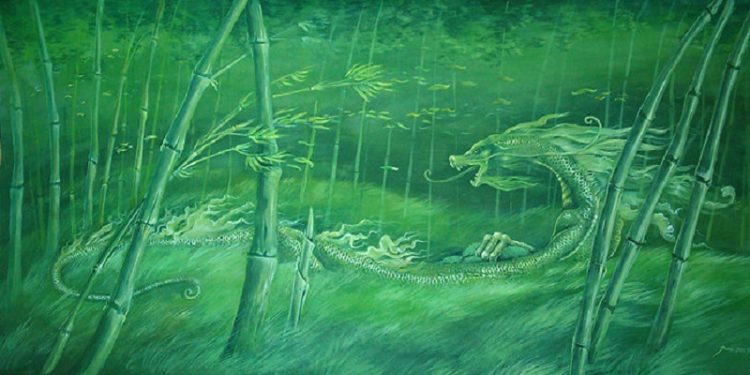Warrior Orders and the Way of the Jade Serpent

We’ve made it through quite a few classes thus far, with no signs of stopping. Way back when I started this whole drug-addled exploration into a world protected by the Zodiac from the fearsome influence of the Far Realm, I imagined a tense world covered in darkness and snow. Only flickering torchlight illuminates the darkness, casting deeper shadows on everything the light doesn’t touch. There are roars and screams in the darkness, and it is worth more than your life to investigate the cause. The world is struggling to find a way to survive against nightmarish alien incursions while continuing to struggle for their wants and desires. In such a world, it makes sense that there would be different orders or schools dotting the land for those studying martial pursuits. Nobles looking to expand their influence would leverage these schools, and encouraging competition and dominance over others outside their control. With all this in mind, let’s take a closer look at Warrior Orders and the Way of the Jade Serpent.
Previous Discussions: The Zodiac and the Celestial Sorcerer | Aberrations and the Circle of the Zodiac Druids | Dendar the Night Serpent and the Path of Nightmares Barbarians | Living Stars, Blazozoids, and Zodiac Patron Warlocks | Singing Stars, Erinyes, and the Bardic College of Kindly Song | Bitheism, Clerics, and the Service Domain | Superstition and the Starscarred Fighter
Getting Schooled
One of my favorite books of all time is Musashi by Eiji Yoshikawa. Sure, it’s over 900 pages and carries that distinct Japanese literature style – one I obviously love – but it’s an absolutely phenomenal work of historical fiction. Miyamoto Musashi is a great figure to tell stories about, thanks room for fictional expansion due to the era in which he lived. Facts aside, large portions of the book are dedicated the battles and duels of Miyamoto Musashi. As you might expect, this speaks to the traditions of Japan
Japan has a rich history of martial arts, particular during the years of the samurai. Skilled practitioners would create schools dedicated to a particular style of martial arts – sometimes several schools were created by the same person – and students would sometimes learn at several different schools before opening their own school. Duels were frequent as each school, as each wanted to prove it was the best. This is particularly true from the mid-1500’s through the 1800’s, but by no means is the the only time frame this existed. I’m not an expert so I’ll just leave it at that.
We still see a lot of this existing through to the modern day thanks to the rise of combat sports. If you look way back to the early days of the UFC, the core of the fights revolved around pitting different styles of combat against each other. You might see a boxer against a greco-roman wrestler or a practitioner of sambo versus against a student of Brazilian Jiu Jitsu. As the years have progress, you see gyms forming their own styles of training that incorporate a mix of styles like boxing, krav maga, muay thai, judo, and savate. These gyms often develop into fight stables, with fighters from the same gym competing at different weight classes – or even within the same division. When a fighter leaves one gave gym or trainer for another, there tends to be a lot of bad blood that follows – creating instant drama and tension. Not so far removed from the days of samurai dueling each other to prove they were the best, when you think about it.
The Evolution of the Martial School
It’s probably not a surprise I am not a mixed martial artists – even though I am a fan. Luckily, I have quite a bit of experience with warrior orders when it comes to games. The concept has existed for years within the family of LARPs that Dust to Dust was run under. The family of games began life under the Chimera Interactive production company, before evolving into Rule of 3 Productions. Prior to this family of games, most LARPs in the area didn’t offer a lot of options for people who wanted to be weapon-focused. Fighters could do more damage as they advanced in experience, and got a small amount of physical defenses along the way. That was about it. As time wore on, fighters began to get a wider area of offensive tricks – disarming weapons, breaking weapons and shield, piercing armor, etc – but all fighters were more or less the same when it came to combat. Individual characters had a lot of variation – this family of LARPs is skill-focused and not class-focused – but combat progression and performance were more or less the same across the board.
The Rule of 3 Family of LARPs
The second generation of games within this LARP family developed the idea of martial schools. In their initial iteration, these martial schools gave you additional skills at the – often lossy – cost of your existing skills. Each school required you to use a different style of weapon – sword and shield, a two-handed weapon, bows or crossbows, etc. – wear different types of armor – none, light, medium, and heavy – and you could only be in one school at a time. You learned skills specific to your style that were not available through any other means than advancing through the schools. Subsequent games in the lineage altered this to offer additional skills through progression, but at a cost that would compete with advancing as an undisciplined fighter. Neither approach is better than the other – in my opinion, and each has its pros and cons.
Martial Schools at Dust to Dust
In Dust to Dust, we had a large number of martial schools – though we called them warrior orders, instead. The Dane’s Bulwark were centered around being bodyguards, the Shieldeaters were wild berserkers, the Sand Spire were spear users that fought ghuls and alchemists, the Displaced Hand were performers that secretly learned thrown weapon and bow skills, and the Silver Swordsmen were nobles who taxed the peasants in silver in order to craft weapons that protected them from the shadows. There were many more, but each was rooted in a specific style of combat and was in service of the world itself. These warrior orders often had friendly competitions with each other to prove their style was superior to the styles of others. We worked hard to highlight all of the warrior orders in the story, to varying degrees of success.
Warrior Orders and the Way of the Jade Serpent
It’s only natural in a world on the constant edge of invasion that myriad schools would develop. The schools exist in both cities and in the wilderness. Some openly advertise to gain students, while others are passed only through whispers and word of mouth. Monasteries are a natural fit for warrior orders in this setting, as each would practice its own form of martial arts with their own themes, beliefs, and martial techniques. This isn’t exactly the most revolutionary idea, but it is one that fits the themes and concepts of the setting extremely well.
If you have read any of the series, you’ll find more than one reference to jade and serpents in the works. This is intentional, given the theme of stars, oracles, and cosmic entities. I could certainly see a tale where the other members of the Zodiac sent the Jade Serpent after Pravos to prove his worthiness before he took to the stars – long before the people of the world appeared. Pravos marshaled his forces against the Jade Serpent and defeated it. He laid claim to the title of Jade General, and took his place beside his Zodiac brethren. In such a setting, a school themed after the Jade Serpent would have a rich history to draw upon, and is something of a no-brainer to include. Even more so if you apply that to the sort of martial mystic that is the monk class as a whole.
Way of the Jade Serpent
Nestled in the foothills of the mountains, the monks of the Way of the Jade Serpent hone the art of channeling their life energy into manifesting the characteristics of their namesake. Those who wish to learn the teachings of the Jade Serpent are welcome to study and practice with them, finding lessons and instruction in the legends left behind that speak of the legendary guardian sent to challenge the worthy. Those that follow the Way of the Jade Serpent believe it is their duty to repeat this feat, challenging any who would seek to elevate themselves above others. Monks who choose to follow the Way of the Jade Serpent tend to dress in vibrant greens and gold. These monks have elaborate tattoos depicting the Jade Serpent covering their bodies – typically adding more as they attain advance their skills.
| Monk Level | Feature |
| 3rd | Sign of the Jade Serpent |
| 6th | Breath of the Jade Serpent |
| 11th | Presence of the Jade Serpent |
| 17th | Heir of the Jade Serpent |
Sign of the Jade Serpent
Starting when you choose this tradition at 3rd level, you have mastered the sign of the Jade Serpent, imbuing you with lightning. You gain a ranged spell attack that you can use with the Attack action. The attack has a range of 30 feet. You are proficient with it, and you add your Dexterity modifier to its attack and damage rolls. Its damage is lightning, and its damage is a d4. This die changes as you gain monk levels, as shown in the Martial Arts column of the Monk table.
When you use the Attack action on your turn to use this special attack, you can spend 1 ki point to make two additional attacks with it as a bonus action. Additionally, when you use the Attack action on your turn to use this special attack, you may use your bonus action to arc the lightning and make an attack roll against a different creature within 30 feet.
Breath of the Jade Serpent
At 6th level, you have learned to manifest the breath of the Jade Serpent. As an action, you may spend 2 ki points to breathe a cloud of poisonous gas in a 30-foot long and 5-foot wide line in front of you. Creatures caught in this cloud make a Constitution saving throw. A creature suffers 2d6 poison damage and becomes poisoned until the end of your next turn on a failed saving throw, or half as much damage and is not poisoned on a successful one.
You can spend additional ki points to increase your breath’s potency. Each additional ki point you spend increases the breath’s damage by 1d6. The maximum number of ki points (2 plus any additional points) that you can spend on the breath equals half your monk level (round down).
Presence of the Jade Serpent
At 11th-level, you have learned to bring a portion of the Jade Serpent’s presence into the world. As an action, the presence of the Jade Serpent fills you. You gain temporary hit points equal to 1d8 + twice your monk level. You gain the ability to spend 2 ki to cast shield as long as these temporary hit points remain.
Once you have used this feature, you may not do so again until you complete a long rest.
Heir of the Jade Serpent
Upon reaching 17th level, you have have become an heir of the Jade Serpent. As an action, you invoke the lineage of the Jade Serpent. This lasts for one minute or until you are incapacitated, and allows you to spend ki points on your turn in the following ways:
- When you hit a creature with a spell attack roll granted by sign of the jade serpent, you may spend 1 ki point to cause the creature hit to succeed on a Constitution saving throw or be stunned until the end of your next turn.
- You may spend 1 ki point to empower presence of the jade serpent until the end of your turn. When you use this empowered presence of the jade serpent, whenever you spend ki points to cast shield, the creature attacking you suffers lightning damage equal to your Wisdom modifier.
- You may spend 2 ki points to gain a flying speed equal to your speed until the end of your next turn.
- You may spend 2 ki points to cause your attacks to deal an additional 1d4 poison damage for the duration of heir of the jade serpent.
- You may spend 3 ki points to empower breath of the jade serpent until the end of your turn, causing it to become a 30-foot cone and saving throws against it to be made with disadvantage. You may spend an additional 2 ki points to allow a number of creatures up to 1 + your Wisdom modifier within your breath of the jade serpent to be unaffected by it, and instead gain temporary hit points equal to the amount of damage they would have taken.
- You may spend 5 ki points to gain resistance to bludgeoning, slashing, and piercing damage for the duration of heir of the jade serpent.
Once you have used this feature, you may not do so again until you complete a long rest.
***Art by Jana Souflova***



